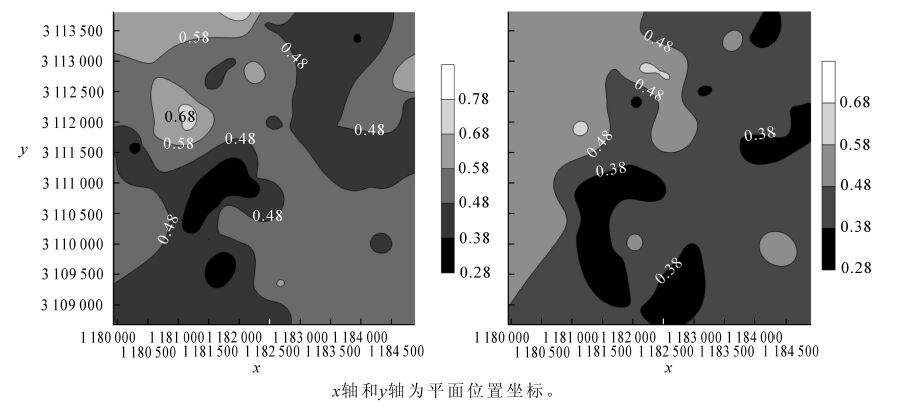-
海涂围垦是扩展港口、工业发展空间和城市建设用地的有效途径。近几年来,沿海地区向浅海和滩涂地带迅速扩张,围垦和填海造陆势不可挡。浙南椒江、瓯江、鳌江的海涂面积为6.8万hm2,已围垦利用面积1.3万hm2。温州滩涂围垦总体规划显示:全市适宜造地的规划滩涂区面积约为4.5万hm2,至2020年滩涂围垦总建设规模3.4万hm2。另外,围垦区城市绿化是改善城市环境和提高广大市民生活品质的公益事业,也是彰显建设环境友好型宜居城市的一个重要标志,而城市绿化离不开土壤,城市绿化土壤作为植物生长的物质基础,其品质直接影响着植物的健康生长以及生态效益、景观功能的发挥。因此,开展海涂围垦区土壤品质调查和评价对于合理开发利用围垦区土壤,并提高土壤生产力具有非常重要的战略意义。到目前为止,国内外学者在土壤品质评价方面开展了大量的研究,主要集中在耕地[1-3]、农副产品用地[4-6]和林业用地[7-9],对于滨海盐碱地的研究也有少量报道[10-12]。在评价过程中,使用的方法主要包括模糊综合评价法[13-14]、最小数据集[15-16]、主成分分析[17]等,并且随着科学技术的发展,地理信息系统(GIS)技术[18]、多变量最优化能量色散X射线荧光和散射光谱[19]、X射线断层成像[20]等方法也逐渐应用于土壤品质评价和监测。一般情况下,滨海围垦区土壤主要分建设用地和城市绿化用地。由于浙南滨海围垦区土壤属于典型的泥质海岸盐碱土,土壤板结严重,极不利于植物生长,造成绿化建设困难,生态环境脆弱。本研究以浙南瓯江口围垦区为研究区域,通过取样调查该区域土壤基本理化性质,利用模糊数学中的隶属函数法结合相关分析法,对土壤品质进行综合评价,并运用全球定位系统(GPS)定位,ARCGIS分析软件进行空间坐标转换和Surfer软件绘制等值线图,从而获得该区域土壤品质的空间分布情况,以期系统掌握该围垦区土壤品质现状和空间分布特性,为绿地系统的规划建设、土壤改良措施和植被构建提供参考依据。
HTML
-
研究区域为浙江省温州市瓯江口新区的起步区和浅滩一期区,总面积为24 km2。根据瓯江口新区规划,该研究区域总绿地面积为4.37 km2,主要包括城市公园9个,广场2个,景观道路19条。该区域地处东海与瓯江的交汇处,属于中亚热带海洋性季风气候区,年均降水量为1 674.3 mm,主要集中在3-9月。
-
于1月下旬,在研究区域范围内,根据植被情况和建设规划用途,在非绿化建设用地,0.5 km2设置1个取样点,每个取样点采用“蛇形法”,由8~12个点混合组成(有植被区域点少,无植被区域点多),而绿化用地,0.2 km2设置1个取样点,每个取样点采用“蛇形法”(公园和广场区域)或“棋盘法”(景观道路区域),由8~12个点混合组成,总共布设了61个取样点。每个样点均对表层土(0~20 cm)和下层土(40~60 cm)分别取样,为保证样品的代表性,每个样点均做复样采集,将其相同土层的土壤混合均匀成混合样,组成待测样品。同时,表层土壤进行土壤容重测量,环刀采样。鉴于最上层土壤易受到干扰,因此,以5~15 cm土壤容重作为本研究表层土容重。采样点的坐标采用GPS定位仪记录。采集样品时,距离最后一次降雨已有12 d,部分区域地表出现干裂。
室内分析测试指标包括有机质、全氮、有效磷、速效钾、pH值和含盐量。除pH值外,其他指标测量方法均参照《土壤农化分析》[21]。土壤有机质质量分数采用重铬酸钾氧化-外加热法;全氮质量分数采用半微量开氏法;有效磷测定采用碳酸氢钠-钼锑抗比色法;速效钾测定采用醋酸铵浸提-火焰光度法;土壤含盐量采用V(水):V(土)=5:1浸提-电导法。土壤pH值测定采用电位法[22]。
1.1. 研究区概况
1.2. 样品采集与分析
-
土壤容重大小反映土壤结构、透气性、透水性能以及保水能力的高低。土壤容重越小说明土壤结构、透气透水性能越好。一般耕作层土壤容重约为1.0 g·cm-3,本研究区域土壤容重均值为1.32 g·cm-3,最大值达到1.61 g·cm-3(表 1),说明该区域土壤普遍表现为紧实趋势,这也是泥质海岸带土壤的特点之一。表层土壤含盐量和下层土壤含盐量平均值分别为7.7和6.6 g·kg-1,中位值分别为4.0和4.5 g·kg-1,均达到重度盐渍化土壤标准[23-24]。有机质、全氮、有效磷和速效钾在表层中的平均质量分数分别为17.94 g·kg-1,0.69 g·kg-1,4.82 mg·kg-1和0.62 g·kg-1,在下层中的质量分数分别为17.10 g·kg-1,0.63 g·kg-1,4.52 mg·kg-1和0.69 g·kg-1。根据土壤养分全国统一划分的6级制分级标准评判,该研究区域有机质质量分数偏少,能够满足一般花草种植所需,但不能满足行道树种植;总氮、有效磷质量分数偏低,而速效钾总体相对较为丰富。表层和下层的pH值均值分别为pH 8.25和pH 8.48,都属于碱性土壤。另外,从变异系数来看,该区域土壤含盐量变异系数最大,分别为103.90%和93.94%,容重和pH值变异系数较小,其余各指标变异系数为20.80%~47.83%,呈中等变异强度。总体上,该研究区域土壤品质较差,主要是含盐量高,肥力偏低,并且盐分分布极不均匀。
土层 项目 土壤容重/ (g·cm-3) 含盐量/ (g·kg-1) 有机质/ (g·kg-1) pH值 总氮/(g·kg-1) 有效磷/(g·kg-1) 速效钾/ (g·kg-1) 最小值 0.90 0.40 1.74 7.02 0.17 0.68 0.09 最大值 1.61 32.60 31.53 9.33 2.38 17.40 1.15 平均值 1.32 7.70 17.94 8.25 0.69 4.82 0.62 表层土中位值 1.36 4.00 18.38 8.20 0.67 4.60 0.61 标准差 0.16 8.00 4.95 0.42 0.33 2.09 0.27 变异系数/% 12.12 103.90 27.59 5.09 47.83 43.36 43.55 偏度 -0.77 1.37 -0.47 -0.20 2.66 3.73 -0.01 峰度 0.12 1.43 1.79 0.79 11.76 21.98 -1.00 最小值 0.30 4.20 7.40 0.20 1.43 0.14 最大值 32.00 35.83 9.77 1.51 8.10 1.30 平均值 6.60 17.10 8.48 0.63 4.52 0.69 下层土 中位值 4.50 17.18 8.45 0.57 4.60 0.71 标准差 6.20 5.54 0.44 0.24 0.94 0.28 变异系数/% 93.94 32.40 5.19 38.10 20.80 40.58 偏度 1.47 0.23 0.30 1.21 0.20 -0.15 峰度 3.28 1.18 0.47 2.46 4.00 -0.97 Table 1. Statistical feature values of soil quality evaluation indices of topsoil and subsoil (n=61)
由表 2可知:容重与含盐量、pH值、速效钾呈极显著相关,说明在泥质海岸围垦区容重是土壤品质评价的重要指标。在表层土壤中含盐量与容重、pH值呈极显著负相关,与速效钾质量分数呈极显著正相关,而在下层土壤中含盐量与pH值呈极显著负相关,与全氮、速效钾呈极显著正相关,与有机质呈显著性正相关,这说明盐分是土壤品质的主要限制因子,钾盐也是构成土壤盐分的重要成分,由于土壤结构紧实,透水透气性差,从而限制了土壤中盐分的运移。pH值在表层土壤中与容重、全氮、有效磷质量分数呈显著性正相关,与盐分、有机质呈显著负相关,而下层土壤中与盐分极显著负相关,与有效磷质量分数呈极显著正相关,这表明在pH值是土壤品质重要的评价因子。在表层土壤中,有机质质量分数与pH值、有效磷质量分数呈显著相关;在下层土壤中,与含盐量、全氮、速效钾显著性相关。这种差异很可能是由于该区域是泥质海岸带,土壤容重较大,上层土壤与下层土壤之间物质交流困难造成的。
指标 含盐量 有机质 pH值 全氮 有效磷 速效钾 土壤容重 -0.438** -0.107 0.373** -0.173 -0.038 -0.470** 含盐量 -0.164 0.378** 0.115 -0.169 0.753** 有机质 -0.312* -0.275* 0.325* 0.501** 0.232 pH 值 0.464** 0.111 -0.342** -0.073 -0.215 全氮 0.337** 0.266* -0.015 0.219 0.140 有效磷 -0.135 0.182 0.388** 0.343** -0.110 速效钾 0.675** 0.483** -0.059 0.448** 0.069 说明:表格上方数据为表层土,下方数据为下层土。 Table 2. Pearson correlation matrix of soil evaluation indices of topsoil and subsoil(n=61)
-
由于影响土壤品质的因素很多,需要建立一个较为全面的综合评估方法进行准确判断。首先建立各评价指标的隶属函数进行归一化处理,计算其隶属度值f(x),用来表示各项土壤指标的状态。根据前人的研究基础,再结合该区域滨海围垦区的实际情况特征,本研究选用戒上型隶属函数和戒下型隶属函数2种方法来确定各指标的隶属函数值。其一,戒上型隶属函数,即在一定范围内,评价指标的增长对植物的生长有利好关系,低于此范围对植物生长不利,大于此范围对促进植物生长影响较小。属于此类型的参数包括总氮、有效磷、速效钾、有机质质量分数。其函数关系式为:
其二,戒下型隶属函数,即在一定范围内,评价指标的增长对植物的生长不利,大于此范围对植物生长不利,低于此范围对促进植物生长影响较小。属于此类型的参数包括含盐量、土壤容重和pH值,实际上pH值属于抛物线型隶属函数,植物生长有最佳范围,超出最佳范围,偏离程度越大植物生长越差,甚至不能生长。然而,考虑到该研究区域土壤pH值最低为pH 7.02,属于最佳范围(pH 6.5~pH 7.5),因而也采用戒下型隶属函数来分析。其函数关系式为:
根据上述隶属函数来确定隶属值,首先必须确定各个指标的转折点x1和x2。结合相关文献[10]和滨海围垦区土壤绿化建设要求,分别确定了隶属函数中转折点的相应取值。结果见表 3。
转折点 土壤容重/(g·cm-3) 含盐量/(g·kg-1) 有机质/(g·kg-1) pH值 总氮/(g·kg-1) 有效磷/(mg·kg-1) 速效钾/(g·kg-1) x1 1.25 1.50 8.00 7.50 0.65 4.00 0.04 x2 1.45 4.00 35.00 8.50 1.75 30.00 0.18 Table 3. Value of turning point of each evaluation index in membership functions
-
需要根据各个指标对土壤品质水平总体构成中实际贡献率的大小来确定权重,以保证评价的精度和评价结果的准确性。确定评价指标的权重最常用的方法包括相关分析法、层次分析法、主成分分析法和熵值法等。本研究采用相关分析法来确定权重值,即利用各指标间相关系数来确定权重。首先计算各个参数之间的相关系数,然后求各个参数之间相关系数的均值,以该均值占所有参数相关系数均值总和的比值作为该单项参数的权重。其结果见表 4。
土层 项目 土壤容重 含盐量 土壤有机质 pH值 总氮 有效磷 速效钾 表层土 相关系数均值 0.267 0.336 0.267 0.276 0.219 0.185 0.320 权重 0.143 0.180 0.143 0.148 0.117 0.099 0.171 下层土 相关系数均值 0.385 0.271 0.207 0.282 0.223 0.347 权重 0.224 0.158 0.121 0.164 0.130 0.202 Table 4. Weighing of each evaluation index
-
土壤品质等级是根据各项指标综合评价值来确定。综合评价值(IFI)是根据各项指标的隶属度值和权重值计算获得,计算公式为:${I_{{\rm{FI}}}}{\rm{ = }}\sum\limits_{i = 1}^n {{f_i} \times {w_i}} $。其中:n表示评价指标个数,fi和wi分别表示第i种评价指标的隶属度值和权重值。综合评价值反映了研究区域的土壤品质状况,是土壤品质等级划分的依据。结合浙南滨海滩涂的生态环境现状,参考国内相关研究结果[10],滨海围垦区土壤品质划分等级为:IFI≥0.58,土壤品质较好;0.38<IFI<0.58,土壤品质较差;IFI≤0.38,土壤品质极差。从表 5可以发现:该研究区域表层和下层土壤总体较差,综合评价值IFI低于0.58的样点个数分别占到总数的86.89%和95.08%。表层土壤综合评价值的最大值、平均值以及IFI>0.38的样点数都要高于下层土壤。土壤品质综合评价值等值线图(图 1)显示,该研究区域西北方位(远海位)土壤品质较好,东南方位(近海位)品质较差,并且比较表层等值线图与下层等值线图可以发现,下层土壤区域分布更集中,更均匀,中间对角区域表层土壤品质要略好于下层土壤。
土层 综合评价值心IFI IFI≥0.58/个 38<IFI<0.58/个 IFI≤0.38/个 最小值 最大值 平均值 表层土 0.291 0.764 0.482 8 43 10 下层土 0.297 0.635 0.435 3 36 22 Table 5. Statistics of soil quality classification
2.1. 评价指标描述性统计分析
2.2. 土壤品质综合性评价
2.2.1. 隶属函数的确定
2.2.2. 评价指标权重的确定
2.2.3. 土壤品质综合评价值计算
-
指标的选取是土壤品质评价的核心,直接关系到评价结果的客观性和准确性,指标过多不仅获取难度增大,而且实用性较差,不利于推广。土壤含盐量和pH值是盐碱地最基本的特征指标,也是开展土壤改良的基本依据,在大量盐碱地研究报道中,这2个因子常作为主要指标[25-27]。也有研究表明,在一些土壤品质指标难以获得的情况下,可仅采用土壤有机质、速效养分和土壤盐分进行评价,甚至仅用土壤盐分和有机质也可以得到较好的评价结果[12, 28-29]。土壤容重直接影响土壤中水、气运行,进而影响土壤中物质和能量的运移。容重越大,运移越困难。在调查土壤基本状况或监测改良效果时,容重常作为一个重要评价指标[11, 30-31]。因此,本研究选取了土壤有机质、含盐量、pH值、容重和养分指标来综合评价土壤品质。
姚荣江等[10, 29]研究显示:土壤容重仅与有机质含量显著性相关,并且权重系数最小,但本试验结果发现,容重与含盐量、pH值、速效钾呈极显著相关,并且权重与有机质、pH值的权重相同或接近(表 4)。这表明在浙南海涂围垦区,容重是一个重要指标,调节土壤容重可以影响土壤中的含盐量、pH值和速效钾含量。同时,在大庆[11]、苏北[29]等盐碱地的研究认为,土壤含盐量、pH值变化,会影响土壤养分的供应。本研究中,表土层pH值与含盐量、有机质、全氮、有效磷呈极显著或显著性相关,而下层土含盐量与有机质、pH值、全氮、速效钾呈极显著或显著性相关,这说明土壤含盐量和pH值直接影响土壤养分。
本研究利用模糊数学方法对浙南海涂围垦区土壤进行综合评价,不仅将表层土壤和下层土壤分别进行评价,而且分析了2层土壤的空间分布特征。总体上,围垦较早区域土壤品质较好,表层土壤品质要略好于下层土壤。这可能有以下几个方面的原因:首先,浙南地区属于雨水较多区域,土壤中的盐分随雨水淋溶而减少,但由于土壤容重较大,透水透气性较差,造成雨水较难渗透到下层土壤,相应表层土壤返盐效果也较弱;其次,较早围垦区域已有植被覆盖,以草本植物为主,既可以改善表层土壤的水盐运动,又可以提高表层土壤有机质含量;第三,较早围垦区域和表土层容易受到人为活动的影响,如开荒种植。因此,获取的土壤品质等级和等值线分布图有利于对该区域更加清晰和直观的认识,从而更好地指导围垦区土壤改良和植被构建。对于品质等级较好和较差的区域,可以通过施加弱酸性有机肥[31-32]、种植耐盐植物[30, 32]逐步改善土壤结构条件,对于品质等级极差的区域,应先经过一定的工程措施,改善土壤结构,提高土壤透水透气性[31-33],再施加弱酸性有机肥、栽植耐盐植物,具体改良措施和植被构建还有待进一步研究探讨。
浙南海涂围垦区土壤体积质量大且盐度高,碱性强;土壤有机质质量分数总体偏少,全氮和有效磷质量分数偏低,速效钾相对丰富;土壤含盐量变异系数大,容重和pH值变异系数较小。相关性分析和权重指数都表明含盐量是滨海围垦区土壤品质的主要限制因子,而容重和pH值与含盐量均存在极显著负相关性,说明在浙南泥质海岸带围垦区土壤品质评价中,容重和pH值也是重要指标。研究区域土壤品质总体较差,并且分布不均,不宜直接进行绿化种植,需要改善土壤结构,提高土壤透水透气性,增加有机质含量,降低土壤盐度和pH值,要注重对下层土壤条件的改良,改善上、下层土壤间的水盐运移环境。








 DownLoad:
DownLoad: